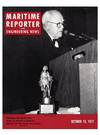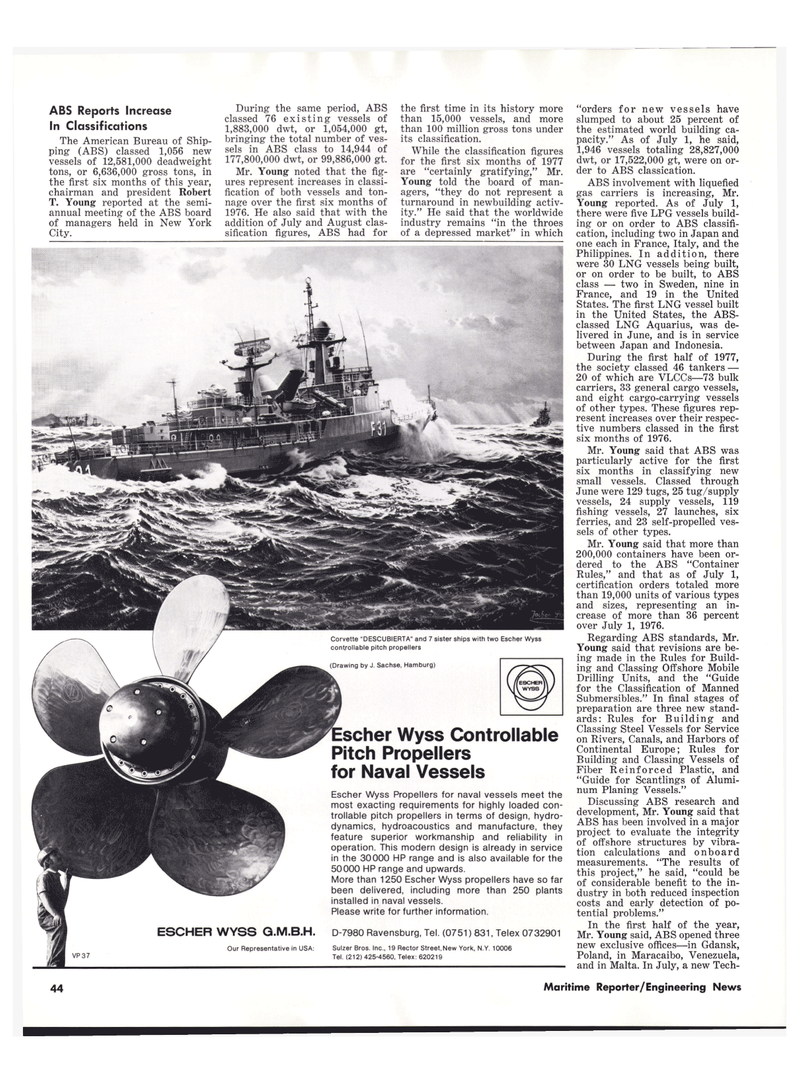
Page 40: of Maritime Reporter Magazine (October 15, 1977)
Read this page in Pdf, Flash or Html5 edition of October 15, 1977 Maritime Reporter Magazine
ABS Reports Increase
In Classifications
The American Bureau of Ship- ping (ABS) classed 1,056 new vessels of 12,581,000 deadweight tons, or 6,636,000 gross tons, in the first six months of this year, chairman and president Robert
T. Young reported at the semi- annual meeting of the ABS board of managers held in New York
City.
During the same period, ABS classed 76 existing vessels of 1,883,000 dwt, or 1,054,000 gt, bringing the total number of ves- sels in ABS class to 14,944 of 177,800,000 dwt, or 99,886,000 gt.
Mr. Young noted that the fig- ures represent increases in classi- fication of both vessels and ton- nage over the first six months of 1976. He also said that with the addition of July and August clas- sification figures, ABS had for the first time in its history more than 15,000 vessels, and more than 100 million gross tons under its classification.
While the classification figures for the first six months of 1977 are "certainly gratifying," Mr.
Young told the board of man- agers, "they do not represent a turnaround in newbuilding activ- ity." He said that the worldwide industry remains "in the throes of a depressed market" in which "orders for new vessels have slumped to about 25 percent of the estimated world building ca- pacity." As of July 1, he said, 1,946 vessels totaling 28,827,000 dwt, or 17,522,000 gt, were on or- der to ABS classication.
ABS involvement with liquefied gas carriers is increasing, Mr.
Young reported. As of July 1, there were five LPG vessels build- ing or on order to ABS classifi- cation, including two in Japan and one each in France, Italy, and the
Philippines. In addition, there were 30 LNG vessels being built, or on order to be built, to ABS class — two in Sweden, nine in
France, and 19 in the United
States. The first LNG vessel built in the United States, the ABS- classed LNG Aquarius, was de- livered in June, and is in service between Japan and Indonesia.
During the first half of 1977, the society classed 46 tankers — 20 of which are VLCCs—73 bulk carriers, 33 general cargo vessels, and eight cargo-carrying vessels of other types. These figures rep- resent increases over their respec- tive numbers classed in the first six months of 1976.
Mr. Young said that ABS was particularly active for the first six months in classifying new small vessels. Classed through
June were 129 tugs, 25 tug/supply vessels, 24 supply vessels, 119 fishing vessels, 27 launches, six ferries, and 23 self-propelled ves- sels of other types.
Mr. Young said that more than 200,000 containers have been or- dered to the ABS "Container
Rules," and that as of July 1, certification orders totaled more than 19,000 units of various types and sizes, representing an in- crease of more than 36 percent over July 1, 1976.
Regarding ABS standards, Mr.
Young said that revisions are be- ing made in the Rules for Build- ing and Classing Offshore Mobile
Drilling Units, and the "Guide for the Classification of Manned
Submersibles." In final stages of preparation are three new stand- ards: Rules for Building and
Classing Steel Vessels for Service on Rivers, Canals, and Harbors of
Continental Europe; Rules for
Building and Classing Vessels of
Fiber Reinforced Plastic, and "Guide for Scantlings of Alumi- num Planing Vessels."
Discussing ABS research and development, Mr. Young said that
ABS has been involved in a major project to evaluate the integrity of offshore structures by vibra- tion calculations and onboard measurements. "The results of this project," he said, "could be of considerable benefit to the in- dustry in both reduced inspection costs and early detection of po- tential problems."
In the first half of the year,
Mr. Young said, ABS opened three new exclusive offices—in Gdansk,
Poland, in Maracaibo, Venezuela, and in Malta. In July, a new Tech-
Corvette "DESCUBIERTA" and 7 sister ships with two Escher Wyss controllable pitch propellers (Drawing by J. Sachse, Hamburg)
Wyss Controllable
Pitch Propellers for Naval Vessels
ESCHER WYSS G.M.B.H. D-7980 Ravensburg, Tel. (0751) 831, Telex 0732901
Our Representative in USA: Sulzer Bros. Inc., 19 Rector Street, New York, N.Y. 10006
VP37 Tel. (212) 425-4560, Telex: 620219
Escher Wyss Propellers for naval vessels meet the most exacting requirements for highly loaded con- trollable pitch propellers in terms of design, hydro- dynamics, hydroacoustics and manufacture, they feature superior workmanship and reliability in operation. This modern design is already in service in the 30000 HP range and is also available for the 50000 HP range and upwards.
More than 1250 Escher Wyss propellers have so far been delivered, including more than 250 plants installed in naval vessels.
Please write for further information. 44 Maritime Reporter/Engineering News

 39
39

 41
41
